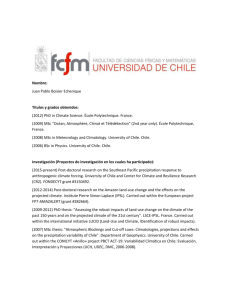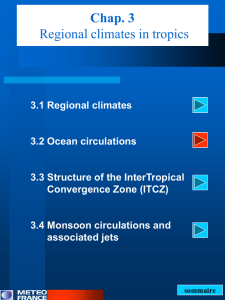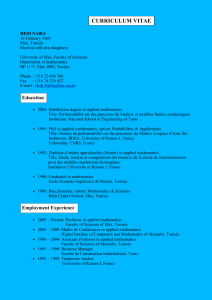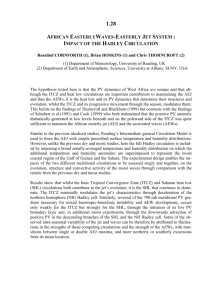PHENOFIT - Natures Sciences Sociétés
advertisement
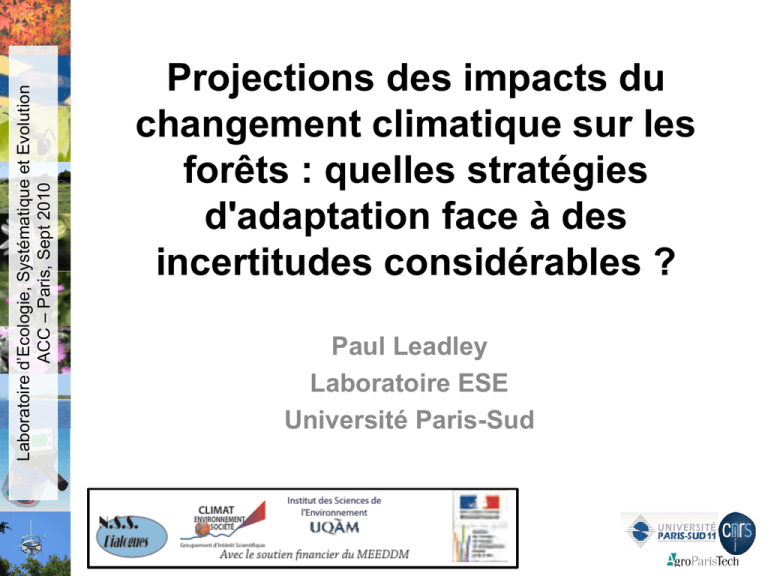
Laboratoire d’Ecologie, Systématique et Evolution ACC – Paris, Sept 2010 Projections des impacts du changement climatique sur les forêts : quelles stratégies d'adaptation face à des incertitudes considérables ? Paul Leadley Laboratoire ESE Université Paris-Sud Laboratoire d’Ecologie, Systématique et Evolution ACC – Paris, Sept 2010 Sources of uncertainty in projections 1. Développement Socio-économique 5. Réponses: Atténuation Adaptation 2. Déterminants de la biodiversité Ex : climat, usage des sols, gestion des ressources génétiques, etc. 3. Etat de la biodiversité Ex : diversité génétique, diversité des especes, communautés, paysages 4. Services Ecosystémiques Ex : provisioning, regulating, sustaining and cutural services Laboratoire d’Ecologie, Systématique et Evolution ACC – Paris, Sept 2010 Model projections of climate change impacts on French forests Laboratoire d’Ecologie, Systématique et Evolution ACC – Paris, Sept 2010 ANR QDiv: Quantification des effets des changements globaux sur la diversité végétale # Laboratoire Site PI 1 ESE, UMR Univ. Paris-Sud / CNRS / ENGREF Orsay Paul LEADLEY 2 FGEP, INRA ClermontFerrand Jean-François SOUSSANA 3 ISEM, UMR Université Montpellier II / CNRS Montpellier Christine DELIRE 4 CEFE, UMR CNRS / Univ. Montpellier I,II,III / CIRAD / ENSAM Montpellier Isabelle CHUINE 5 BIOGECO, UMR CNRS / Univ. Bordeaux 1 Bordeaux Antoine KREMER 6 Arboretum National des Barres, ENGREF Nogent Stephanie BRACHET 7 LECA, UMR CNRS / Université Joseph Fourier Grenoble Sandra LAVOREL 8 Ecologie et Ecophys. Forestières, UMR INRA / Université Nancy Nancy Jean-Luc DUPOUEY 9 LSCE, UMR CEA / CNRS Gif-sur-Yvette Nathalie DE NOBLETDUCOUDRE 10 UMR & USM CNRS / MNHN / Conservatoire Botanique National du Bassin Parisien Paris Nathalie MACHON Laboratoire d’Ecologie, Systématique et Evolution ACC – Paris, Sept 2010 Projecting potential shifts in tree ranges in response to climate change: an intermodel comparison approach to qualifying and quantifying uncertainty Alissar Cheaib1, Christophe François1, Vincent Badeau2, Isabelle Chuine3, Christine Delire4, Eric Dufrêne1, Emmanuel Gritti3, Wilfried Thuiller5, Nicolas Viovy6 and Paul Leadley1 1 Laboratoire d’Écophysiologie Végétale, UMR d’Écologie, Systématique et Évolution CNRS 8079, Université ParisSud XI 91405 Orsay Cedex France 2 UMR 1137, INRA UHP, Forest Ecology and Ecophysiology, Phytoecology Team, route de la Forêt-d’Amance, 54280 Champenoux, France 3 Centre d’Ecologie Fonctionnelle et Evolutive, Equipe BIOFLUX, CNRS, 1919 route de Mende, 34293 Montpellier cedex 4 CNRS Meteo-France – Toulouse, France 5 Laboratoire d’ Écologie Alpine, UMR CNRS 5553 , Université´ J. Fourier, BP 53, 38041 Grenoble Cedex 9 France 6 Laboratoire des Sciences du Climat et de l’Environnement, CEA/ CNRS, Saclay, France. Treating UNCERTAINTY in modeling climate impacts on forests: an example from the ANR QDiv project High resolution (8 km) climate scenarios High resolution (8 km) maps of current tree distributions Collaboration with CERFACS Collaboration IFN (L. Terray) (C. Cluzeau) High resolution maps of key soil properties Furnished by INRA Orléans 10 A broad range of models of tree response to climate change Assessment of climatic risk for: Niche Based BIOMOD NANCY-NBM STASH Quercus petraea Phenology-based PHENOFIT DGVM Orchidée (PFT) IBIS (PFT) LPJ-Guess (Species) Quercus robur Fagus sylvatica Pinus sylvestris Quercus ilex 35 E.g., Simulated mean August temperatures in 2098 E.g., current distribution of Fagus sylvatica (Common beach) Mechanistic Tree growth CASTANEA + Plant functional groups A broad range of modelling concepts: 7 Models Correlative approaches « Niche - Based » Models or « Bioclimate envelope » Models Nancy NBM (V. Badeau, INRA Nancy) BIOMOD (W. Thuiller, 2003. W. Thuiller, Grenoble) STASH (Sykes et al, 1996. E. Gritti, CEFE Montpellier) Mechanistic approaches « Phenology – Based » Model PHENOFIT Tree C balance and Growth CASTANEA (Chuine and Beaubien 2001. I. Chuine, CEFE Montepellier) (E. Dufrêne et al, 2005. C. François and A. Cheaib, ESE Orsay) ORCHIDEE (Krinner et al, 2005. N. Viovy CEA) Dynamic Global Vegetation Models (DGVMs) IBIS (Kucharik et al, 2000. C. Delire Meteo France) LPJ (Stich et al, 2003. E. Gritti, CEFE Montpellier) Climate scenario (regionalized Arpège) : The A1B Story line ~ 8989 pixels in France: Spatial resolution 8Km x 8Km (L. Terray, CERFACS, Meteo France) 800 CO2 CO2 700 Average CO2 CO2 (ppm) 600 500 400 300 TS3 800 TS2 668 600 TS1 400 544 346 200 0 200 Time Slice1 1971- 2000 100 0 1970 1980 1990 Time Slice 2 2046 - 2065 2000 2010 2020 2030 2040 2050 Time Slice 3 2079-2098 2060 2070 2080 2090 2100 100 80 60 40 20 0 T °C P re c ip ita tio n s (m m ) Year 0 2 4 6 8 10 12 M onth 2050 200 mm/year decrease in precipitation 25 20 15 10 5 0 0 2 4 6 8 10 12 M onth 2050 2.85°C mean temperature increase Laboratoire d’Ecologie, Systématique et Evolution ACC – Paris, Sept 2010 Fagus sylvatica European beech Hêtre commun Current distribution simulations and model evaluation Fagus sylvatica Models Evaluation: True Skill Statistic (TSS) method (Allouche et al, 2006) TSS = Sensitivity + Specificity - 1 Sensitivity = True presence / (True presence + false absence) Proportion of observed presences that are predicted as such: quantifies omission errors Specificity = True absence / (True absence + false presence) Proportion of observed absences that are predicted as such: quantifies commission errors TSS = 0.73 BIOMOD TSS = 0.16 TSS = 0.66 Nancy NBM TSS = 0.18 STASH TSS = 0.48 TSS = 0.33 Current distribution (IFN) 0 : N o fo re s t 1: A bsence 2 : P re s e n c e PHENOFIT CASTANEA LPJ Fagus sylvatica NE Vosges NW 2050 Projections of distribution -0.174 -0.40 Alsace -0.453 100 % 48 % -0.55 58 % 84 % V Saône 53 % 70 % Y axis (Sum 2050 - Sum Current) Sum Current Brittany -0.479 Jura 99% -0.553 SW -0.038 82 % 16 % Alps 58 % -0.70 0.073 Average response 75 % Center Pyrenees -0.426 0: No forest 1: Absence 2: Presence -0.16 Fagus sylvatica 2050 Projections of distribution NW -0 -0.453 Y axis (Sum 2050 - Sum Current) Sum Current 48 % 53 % Brittany 0: No forest 1: Absence 2: Presence Fagus sylvatica NE Vosges NW 2050 Projections of distribution -0.174 -0.40 Alsace -0.453 100 % 48 % -0.55 58 % 84 % V Saône 53 % 70 % Y axis (Sum 2050 - Sum Current) Sum Current Brittany -0.479 Jura 99% -0.553 SW -0.038 82 % 16 % Alps 58 % -0.70 0.073 Average response 75 % Center Pyrenees -0.426 0: No forest 1: Absence 2: Presence -0.16 Fagus sylvatica Examples Tests of mechanisms 1 Niche models show a strong negative response to warming, this response is weaker or even reversed in mechanistic models (TS2-TS1)/TS1 BIOMOD NE PHENOFIT Jura Current Temp 2050 Temp 2050 Current Temp Temp PHENOFIT CASTANEA Alsace 2 Mechanistic models are very responsive to reductions in precipitation (TS2-TS1)/TS1 V Saône 2050 Current Rainfall Rainfall 2050 Rainfall LPJ (TS2-TS1)/TS1 Rising CO2 offsets negative climate change impacts in mechanistic models (not accounted for in niche models) (TS2-TS1)/TS1 CASTANEA 3 Current Rainfall Alps NE 2050 CO2 2050 CO2 Current CO2 Current CO2 NE Alps Laboratoire d’Ecologie, Systématique et Evolution ACC – Paris, Sept 2010 Beech: Take home messages • Bioclimatic-envelope models do a remarkably good job of simulating current distributions, in some cases with as few as three climate parameters. • Bioclimatic-envelope models project nearly complete loss of favorable climate in the plains of France by 2050 for this A1b climate scenario and “average” soils. This appears to be driven largely by high sensitivity to climate warming. • Mechanistic models project small or moderate losses of favorable climate in the plains and increased range in mountains. Most models project increased productivity in the Northern plains and mountains (not shown). Rising CO2 plays a key role in counteracting negative effects of climate change. • Recent observations and experiments tend to side with mechanistic models, but “hidden” or long-term effects (e.g., competition, disease, regeneration) might explain current and future distributions as simulated by bioclimatic models Laboratoire d’Ecologie, Systématique et Evolution ACC – Paris, Sept 2010 Pinus sylvestris Scots pine Pin sylvestre Current distribution simulations and model evaluation Pinus sylvestris TSS = 0.48 BIOMOD TSS = 0.26 Current distribution (IFN) PHENOFIT TSS = 0.03 TSS = 0.30 Nancy NBM TSS = 0.25 STASH TSS = 0.26 LPJ TSS = 0.07 0 : N o fo re s t 1: A bsence 2 : P re s e n c e Needleleaf Evergreen ORCHIDEE IBIS Pinus sylvestris NE Vosges NW Projections for 2050 -0.310 -0.678 -0.922 82 % 41 % Alsace 46 % 55 % 33 % 35 % -0.661 V saône -0.708 Brittany Jura 49 % Y axis -0.943 (Sum TS2-SumTS1) SumTS1 -0.098 72 % SW 16 % -0.082 -0.932 Average models 38 % Pyrenees 0: No forest 1: Absence 2: Presence Alps 68 % -0.247 Center -0.555 Pinus sylvestris 1 All models are highly sensitve to warming BIOMOD Vosges (TS2-TS1)/TS1 Tests of mechanisms T°C TS1 Current Temp 2050 Temp Vosges NE (TS2-TS1)/TS1 PHENOFIT NE 3 Rising CO2 attenuates climate change impacts in mechanistic models LPJ Vosges (TS2-TS1)/TS1 All models are relatively insensitive to reductions in precipitation LPJ (TS2-TS1)/TS1 2 PHENOFIT NE 2050 Current Rainfall Rainfall NE Vosges 2050 CO2 Current CO2 Laboratoire d’Ecologie, Systématique et Evolution ACC – Paris, Sept 2010 Scots Pine: Take home messages • Current distributions are difficult to simulate, in part due to use of Scots pine outside its natural range • All models project substantial loss of favorable climate in the plains of France by 2050 for this A1b climate scenario and “average” soils. This is driven by high sensitivity to climate warming in all models. Laboratoire d’Ecologie, Systématique et Evolution ACC – Paris, Sept 2010 Quercus ilex holm oak chêne vert Quercus ilex 2050 2050 0: No forest 1: Absence 2: Presence BIOMOD NBM Nancy 2050 LPJ 2050 STASH 2050 ORCHIDEE 2050 IBIS Evergreen Broadleaf Laboratoire d’Ecologie, Systématique et Evolution ACC – Paris, Sept 2010 Forest plant diversity Identifier des modifications en cours de l’aire de distribution des espèces au travers des relevés de l’Inventaire forestier national (IFN). – J-L Dupouey, V Badeau (EEF, INRA Nancy) Arpège B2 Climate simulation + Statistical distrubution model Current Statistical model based on IFN and AURELHY climate data 2100 Projected distrubution Evolution de la composante méditerranéenne de la végétation forestière entre 1990 et 2100 selon le scénario climatique Arpège B2 de Météo-France. Laboratoire d’Ecologie, Systématique et Evolution ACC – Paris, Sept 2010 Adaptation: What to do in the face of uncertain impacts? Laboratoire d’Ecologie, Systématique et Evolution ACC – Paris, Sept 2010 Adaptation of French forests to climate change An ONF/INRA manual of management techniques to limit climate change impacts on forests Laboratoire d’Ecologie, Systématique et Evolution ACC – Paris, Sept 2010 Laboratoire d’Ecologie, Systématique et Evolution ACC – Paris, Sept 2010 Examples of adaptive management strategies • Reinforce “natural” processes to increase resilience • Reduce exposure to climate change • Plant species or genotypes, including introduced species, that are more tolerant of projected changes in climate Laboratoire d’Ecologie, Systématique et Evolution ACC – Paris, Sept 2010 Reinforce “natural” processes to increase resilience • Increase the use of mixed species stands • Maintain or increase genetic diversity, e.g., through natural regeneration rather than the planting of clones • Respect knowledge of tree ecology (e.g., soils, climate) • Avoid soil compaction during forestry activities • Reduce evapotranspiration through management of leaf area Laboratoire d’Ecologie, Systématique et Evolution ACC – Paris, Sept 2010 Reduce exposure to climate change Old growth Douglas fir Laboratoire d’Ecologie, Systématique et Evolution ACC – Paris, Sept 2010 Reduce exposure to climate change • Reduce rotation times. Shift to fast growing trees (esp. conifers) or to “coppice” plantations (if 2nd generation biofuels take off, GM trees are permitted). Douglas fir (Pseudotsuga sp.) plantation Coppice poplar plantation Laboratoire d’Ecologie, Systématique et Evolution ACC – Paris, Sept 2010 Plant species or genotypes that are more tolerant of “predicted” changes in climate • Introduce new drought and heat tolerant species and genotypes, i.e., introduced species and possibly GM trees. • Use transplants exploiting the natural differences in genotypes across species range Use provenance trials and other information to identify ‘pre-adapted’ genotypes, e.g., lodgepole pine in W. Canada (O’Neill et al. 2007, Wang et al. 2010) Eucalyptus plantation Laboratoire d’Ecologie, Systématique et Evolution ACC – Paris, Sept 2010 Plant species or genotypes, including introduced species, that are more tolerant of projected changes in climate • Introduce drought and heat tolerant species, possibly including GM trees. • Use transplants exploiting the natural differences in genotypes across species range Use provenance trials and other information to identify ‘pre-adapted’ genotypes, e.g., lodgepole pine in W. Canada (O’Neill et al. 2007, Wang et al. 2010) Eucalyptus plantation Laboratoire d’Ecologie, Systématique et Evolution ACC – Paris, Sept 2010 Conclusions • There is a tremendous need to improve biodiversity scenarios and their use in management and political decision making • Regardless of the advances in scenarios we will face difficult choices for forest management in the face of very large uncertainties 15-16 Sept, Paris The way forward Programme Phare: Modélisation et scénarios de la biodiversité ‘Humboldt’ project Quercus robur Vosges NE NW -0.254 -0.276 0.009 72 % 80 % 78 % 0: No forest 1: Absence 2: Presence -0.322 95 % V Saône 80 % Y axis Alsace 85 % -0.406 Brittany Jura 75 % (Sum TS2-SumTS1) SumTS1 -0.218 0.128 72 % SW Alps 15 % 78 % -0.439 0.039 Average models 78 % Pyrenees -0.206 Center -0.421 Quercus robur Hypothesis: Tests Examples 1 T°C of TS1 TS2 Climate NE PHENOFIT Jura (TS2-TS1)/TS1 BIOMOD T°C TS1 T°C TS1 (TS2-TS1)/TS1 LPJ LPJ Jura NE T°C TS1 T°C TS1 Rainfall of TS1 CO2 TS1 3 TS2 Climate LPJ (TS2-TS1)/TS1 TS2 Climate (TS2-TS1)/TS1 BIOMOD 2 NE PHENOFIT V Saône Rainfall TS1 Rainfall TS1 Alps NE CO2 TS1 CO2 TS1 TeBS NE NW Vosges -0.165 -0.245 -0.073 100 % Alsace 85 % 0: No forest 1: Absence 2: Presence 98 % 88 % -0.177 80 % 98 % Y axis V Saône -0.267 Brittany 99 % Jura -0.234 (Sum TS2-SumTS1) SumTS1 95 % SW -0.483 0.013 61 % Alps 86 % -0.022 Average models 79 % Center Pyrenees -0.343 -0.190 Temperate Broadleaf Summergreen 1 T°C of TS1 (TS2-TS1)/TS1 BIOMOD Alps NE T°C TS1 T°C TS1 TS2 Climate (TS2-TS1)/TS1 ORCHIDEE TS2 Climate CO2 TS1 3 TS2 Climate ORCHIDEE (TS2-TS1)/TS1 2 ORCHIDEE (TS2-TS1)/TS1 Rainfall of TS1 Alps NE T°C TS1 T°C TS1 Alps NE Rainfall TS1 Rainfall TS1 Alps CO2 TS1 NE CO2 TS1
